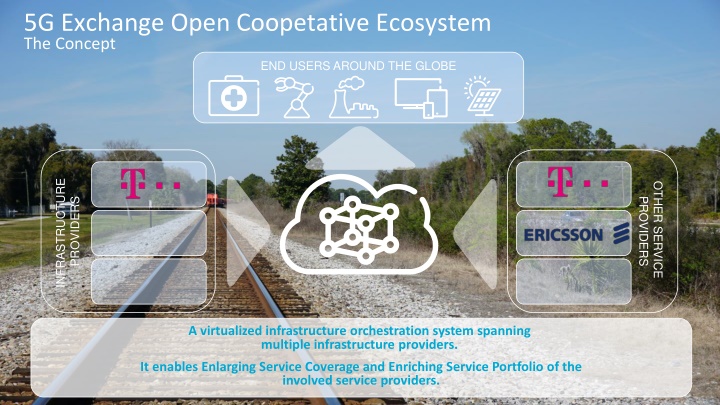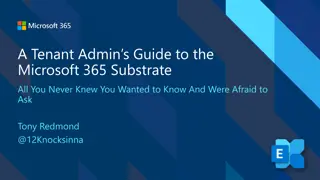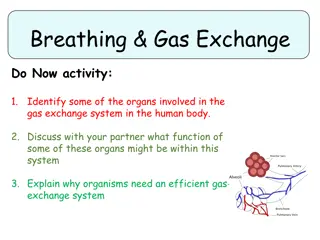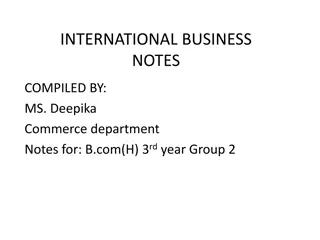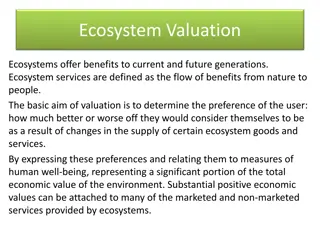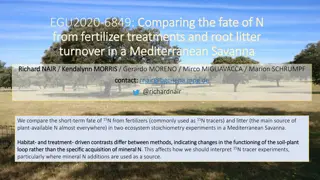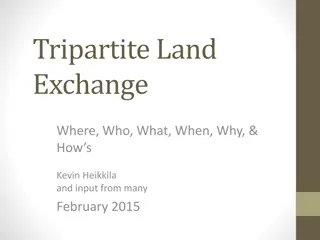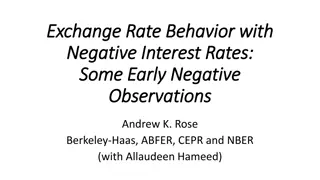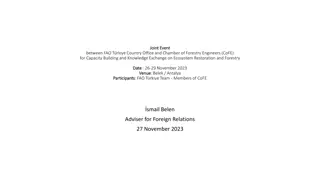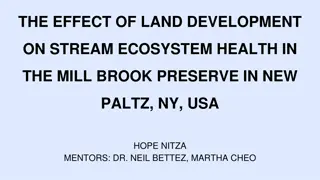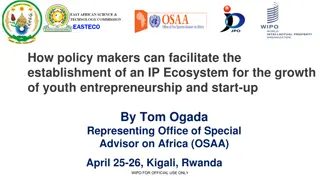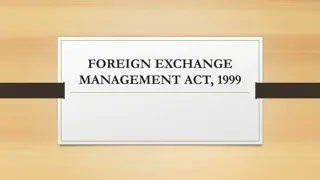5G Exchange Open Coopetative Ecosystem
An innovative concept promoting service collaboration among providers, enabling seamless user experience globally. The ecosystem facilitates automated resource sharing, expanding service coverage and portfolio. It emphasizes critical communication, cloud-enabled factory control, and NFV orchestration for efficient operation across multiple infrastructure providers.
Download Presentation

Please find below an Image/Link to download the presentation.
The content on the website is provided AS IS for your information and personal use only. It may not be sold, licensed, or shared on other websites without obtaining consent from the author.If you encounter any issues during the download, it is possible that the publisher has removed the file from their server.
You are allowed to download the files provided on this website for personal or commercial use, subject to the condition that they are used lawfully. All files are the property of their respective owners.
The content on the website is provided AS IS for your information and personal use only. It may not be sold, licensed, or shared on other websites without obtaining consent from the author.
E N D
Presentation Transcript
5G Exchange Open Coopetative Ecosystem The Concept END USERS AROUND THE GLOBE INFRASTRUCTURE OTHER SERVICE PROVIDERS PROVIDERS A virtualized infrastructure orchestration system spanning multiple infrastructure providers. It enables Enlarging Service Coverage and Enriching Service Portfolio of the involved service providers. Ericsson Internal | 2017-02-14 | Page 1
5g Exchange Open Coopetative Ecosystem Enlarged Service Coverage Default Service Provider s Coverage Area Partner Service Provider s Coverage Area The ecosystem makes it possible for end users to have the same user experience both in terms of functionality and service characteristics independent of their location or consumption worldwide. This is achieved by automated resource sharing among infrastructure or online providers. Service resources Service resources If the end user demands a service at a new location where the infrastructure is not owned by the default provider then the default provider may automatically lease resources from other providers to fulfill the service request at the desired location. Default Service Provider s Infrastructure Partner Service Provider s Infrastructure Ericsson Internal | 2017-02-14 | Page 2
Critical Machine Type Communication 5G Radio & CORE for Latency Guarantees Ericsson Internal | 2017-02-14 | Page 3
Cloud-enabled Factory Control For Complex & Cooperative Tasks, Scalability & Flexible Reconfiguration ~2-8ms cycle time is needed for the safe operation Ultra-low Latency is critical for process operation: delay limit violation or/and delay variation causes serious service degradation/collapse Deployment of virtualized Control functions has to fulfill the latency requirements High reliability is required to avoid unnecessary service collapse in case of a failure on the communication path Target Fault tolerance level can only be guaranteed by the proper isolation of networking and compute resources Orchestration solution is needed for integrated and automated handling of the (virtualized) compute and networking resources, with fulfillment of latency and reliability requirements considering multi-domain, multi-provider environment Ericsson Internal | 2017-02-14 | Page 4
Multi-Provider Factory Automatization A Showcase for NFV Orchestration Factory premise: Industry Cloud with computing and networking resources managed by the Factory owner + Orchestrator 5G-based Local network (including radio, transport, required core entities) deployed and managed by the Regional Provider +Orchestrator Ultra-low latency is provided among devices/functions deployed at Factory premise International provider Orchestration Regional provider Factory premise Reginal provider with orchestrated networking and compute resources Higher delay has to be considered towards Factory premise Network is managed by the Regional Operator Orchestration Orchestration International Provider Top orchestrator: integration of Regional Providers SDN SDN Latency=10ms Cloud-enabled Factory Automation control: e.g. PLC as VNF Can be deployed on Factory local or remote sites depending on latency, reliability requirements of the service SDN Latency=10ms Latency=5ms Latency=2ms Orchestration SDN Multi-operator, Multi-domain hierarchical Orchestration Integrated and automated resource handling Latency and reliability requirements are considered Industry Cloud deployment Ericsson Internal | 2017-02-14 | Page 5
Demo setup Demo details Balancing Robot (as Industry Device) SDN domains realized by Mikrotik SDN switches Two WLAN Aps (TP- Link) WiFI AP1 WiFI AP2 Mikrotik switch_2 Mikrotik switch_1 Eth 3 Eth 3 SDN1 Eth 4 SDN2 Eth 4 Eth 5 Eth 5 Eth 6 Eth 6 Eth 7 Eth 7 SDN4 SDN3 Eth 8 Eth 8 Eth 9 Eth 9 1 2 3 4 4 Docker domains running on different blades of a TranquilPC cluster server Represents Factory and Remote domain Factory premise Remote domain Robot Balancing Control function (vCont) running on a Docker container Ericsson Internal | 2017-02-14 | Page 6
Case 1: Controller deployment with ultra low latency International provider Service request Req: ultra low latency Orchestration Regional provider Factory premise Req: ultra low latency Service request: strict latency, but low reliability requirement Only duplicated Controller functions required Network is managed by the Regional Operator Orchestration Orchestration Orchestration is done by considering latency requirement SDN SDN Latency=10ms SDN Latency=10ms Latency=5ms Latency=2ms Low reliability level Fault tolerance to software errors (e.g. vContr failure) Partial tolerance to network failures (partially isolated network paths) Datacenter hardware error is critical Orchestration SDN Industry Cloud deployment DC3 DC4 DC1 DC2 Ericsson Internal | 2017-02-14 | Page 7
Case 2: Reliable controller deployment International provider Req: ultra low latency Service request Orchestration Req: Anti-affinity Regional provider Factory premise Req: ultra low latency Service request: strict latency, moderate reliability requirement Network is managed by the Regional Operator Orchestration Orchestration is done by considering latency + reliability requirement Orchestration SDN SDN Latency=10ms SDN Middle reliability level Fault tolerance to software and datacenter hardware errors (e.g. vContr failure) Partial tolerance to network failures (partially isolated network paths) Latency=10ms Latency=5ms Latency=2ms Orchestration SDN Industry Cloud deployment Ericsson Internal | 2017-02-14 | Page 8
Case 3: end-to-end reliability International provider Req: ultra low latency Service request Orchestration Req: End-to end reliability Regional provider Factory premise Req: relaxed latency Service request: end-to-end reliability, relaxed latency requirement on backup path Trade-off between latency and reliability Network is managed by the Regional Operator Orchestration Orchestration Orchestration is done by considering latency + reliability requirement SDN SDN Latency=10ms Latency=10ms SDN Latency=10ms Latency=10ms Latency=5ms Latency=5ms Latency=2ms High reliability level: fault tolerance to any single failure Total resource isolation Orchestration SDN Industry Cloud deployment Ericsson Internal | 2017-02-14 | Page 9
Horizon 2020/ 5G-PPP / 5G Exchange PROJECT INFORMATION Coordinated by Ericsson 5 operators, 5 vendors, 5 Universities, 3 SMEs 1,032 Person Months 8 MEUR grant October 2016 June 2018 http://www.5gex.eu/ Contact: robert.szabo@ericsson.com Standardization activities Coordinated by Ericsson Internal | 2017-02-14 | Page 10
Resource orchestration of reliable c-MTC services Integrated and automated handling of network and compute resources by considering reliability and low-latency requirement Credit: J. Harmatos, D. Jocha, R. Szab , B. Ger (Ericsson) B. N meth, J. Czentye, B. Sonkoly (BME)
